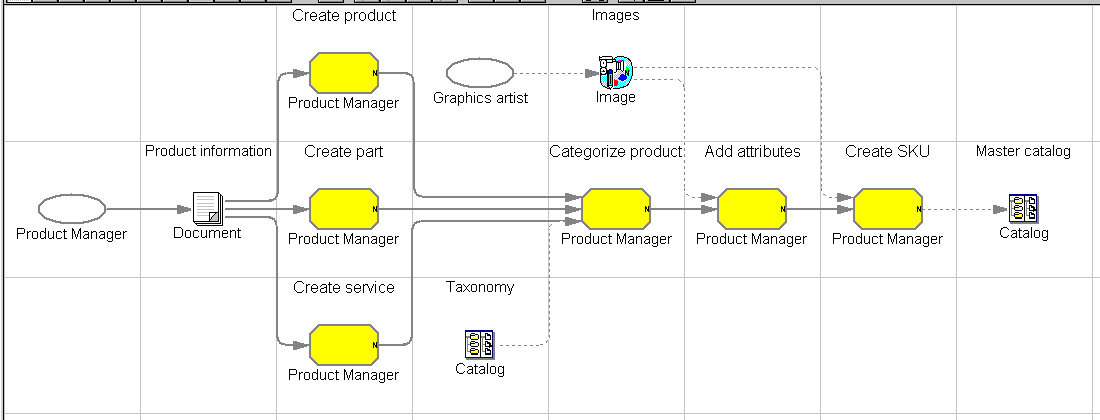Process: Develop products
Flow

Objective
Create and manage a master catalog by manually entering products and SKUs into the taxonomy.
Description
This process creates or updates a master catalog by manually creating products and SKUs and categorizing them into the previously defined taxonomy. Product information can be from a variety of sources - suppliers, manufacturers, or in-house - each with varying formats and taxonomies. Such information must be normalized, rationalized and cleansed before being entered into WebSphere Commerce.
WebSphere Commerce provides a product management user interface to manually enter the information into the WebSphere Commerce database.
Features
- Automatic SKU generation.
- Multiple language support for products and attributes (description and images).
- Multiple currency support for product price.
- User interface support to update multiple products on a single screen.
- User interface supports copying product information from one to another.
- User interface supports search and replace text across products.
- User interface supports preview of images.
Customization
- Reuse products in different master catalogs.
- Algorithmic part numbering for SKU generation.
- Automatic classification of products.
Edition
Professional, Enterprise, Express
Tasks
| Task | Description | Role |
|---|---|---|
| Add attributes |
Add or modify attributes that describe a product, service, part, SKU, kit or bundle. This could include images, additional translated descriptions, manufacturer or supplier data, MSRP, descriptive attribute information, and defining attribute information for products. A combination of the set of defining attribute's values determine the SKUs for a product. |
Product Manager |
| Categorize product |
Add or modify the relationship of a product, part, service, kit or bundle under a category of the hierarchy of the catalog or taxonomy. |
Product Manager |
| Create part |
A part is a product within the master catalog that may not be sold individually but rather is used to build kits and bundles in the catalog. |
Product Manager |
| Create product |
A product is a high level container which defines a set of attributes and its associated possible values. These values describe the SKUs of that particular product. |
Product Manager |
| Create service |
A service is a product within the master catalog that the business provides accompanying another product. Examples of services are warranties, gift wrapping, or personalized messages. |
Product Manager |
| Create SKU |
A SKU represents a buyable instance of a product and is defined by a particular combination of the product's attribute values. For example, a product may be a knit sweater with the following defining attributes: color ( values are red or blue) and size (values are S, M, or L). There could potentially be 6 SKUs associated with the product, one for each combination of the defining attributes (red-S, red-M, red-L, blue-S, blue-M, blue-L). Each SKU may specify its own attributes such as images, MSRP and descriptions. SKUs may be generated based on possible combinations of the product and its defining attributes. |
Product Manager |
Business artifacts
(C) Copyright IBM Corporation 1996, 2006. All Rights Reserved.